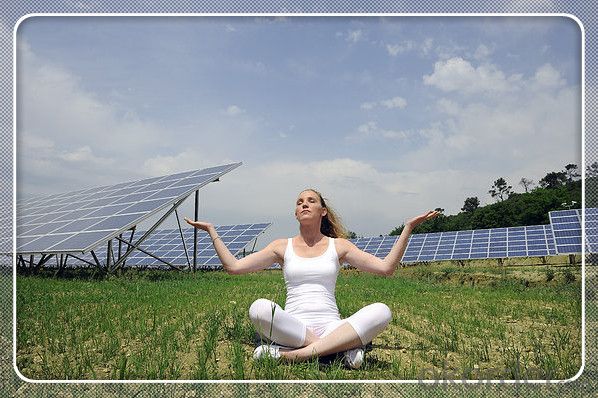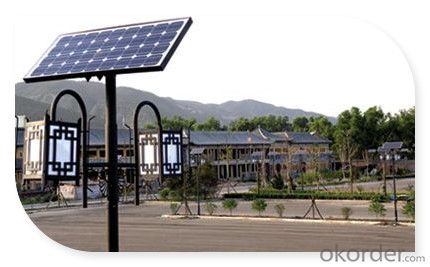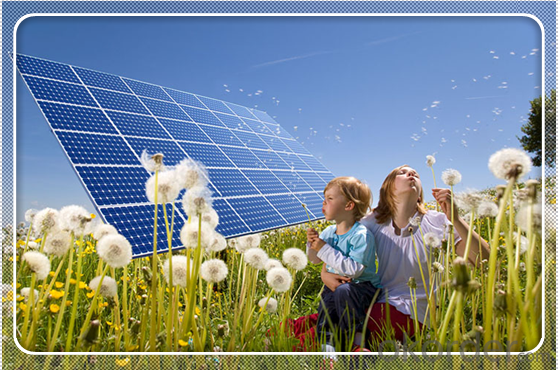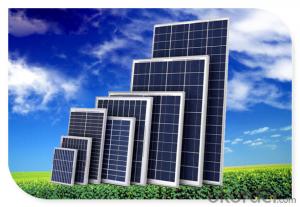75W Efficiency Photovoltaic Chinese Solar Panels For Sale 5-200W
- Loading Port:
- China main port
- Payment Terms:
- TT OR LC
- Min Order Qty:
- 10000 watt
- Supply Capability:
- 100000 watt/month
OKorder Service Pledge
OKorder Financial Service
You Might Also Like
Item specifice




Solar Module Introduction
Solar Module is the core part of solar PV power systems, also is the highest value part of it. The function of Solar Module is to convert the sun's radiation to electrical energy, or transfer it to battery and store in it, or to drive the load running.
The Product has been widely used in space and ground, it mainly used for power generation systems, charging systems, road lighting and traffic signs areas. It could offer a wide range of power and voltage, and with high conversion efficiency, and long service life.
Solar modules use light energy (photons) from the sun to generate electricity through the photovoltaic effect. The majority of modules use wafer-based crystalline silicon cells or thin-film cells based on cadmium telluride or silicon. The structural (load carrying) member of a module can either be the top layer or the back layer. Cells must also be protected from mechanical damage and moisture. Most solar modules are rigid, but semi-flexible ones are available, based on thin-film cells. These early solar modules were first used in space in 1958.
Electrical connections are made in series to achieve a desired output voltage and/or in parallel to provide a desired current capability. The conducting wires that take the current off the modules may contain silver, copper or other non-magnetic conductive transition metals. The cells must be connected electrically to one another and to the rest of the system. Externally, popular terrestrial usage photovoltaic modules use MC3 (older) or MC4 connectors to facilitate easy weatherproof connections to the rest of the system.
Secification
Model Type | |
Peak Power-Pmax(W) | 5-200W |
Open Circuit Voltage-Voc(V) | 44.2 |
Maximum Power Voltage-Vmp(V) | 36 |
Short Circuit Current-Isc(A) | 5.4 |
Maximum Power Current-Imp(A) | 5 |
Maximum System Voltage | 1000V DC |
Maximum Series Fuse Rating | 10A |
Power Tolerance | -1~+3% |
Temperature Coefficients of Pmax | -0.45%/℃ |
Temperature Coefficients of Voc | -0.348%/℃ |
Temperature Coefficients of Isc | 0.031%/℃ |
Nominal Operating Cell Temperature | 44.5±2℃ |
Standard Testing Condition(STC) | Irradiance:1000W/m²;Temperature:25℃;AM=1.5 |
Qualification Test Parameters | |
Operating Temperature | -40℃~+85℃ |
Storage Temperature | -40℃~+85℃ |
Pressure Bearing | ≥5400Pascal/m² |
Wind Bearing | ≥5400Pascal/m² |
Mechanical Characteristics | |
Cell Size | Mono 125*125mm±0.5 |
No.of Cells | 72pcs(6*12) |
Dimension | 1580*808*40mm |
Weight | 15.5Kg |
Glass | 3.2mm High Transmission,Low Iron |
Frame | Anodized Aluminum Alloy |
Junction Box | IP65Rated |
Internal Diodes | 3 Bypass Diodes |
Cable | 1*4.0mm² Length 900mm |
Images
Packing & Shipping:
We have rich experience on how to pack the panels to make sure the safety on shipment when it arrives at the destination.
The normal size is packed by 25pcs/ carton / pallet. Paper carton for FCL shipping and wood carton for LCL shipping.
Warranty:
For c-Si panel: 25years output warranty for no less than 80% of performance, 10 years output warranty for no less than 90% of performance. Free from material and workmanship defects within 5 years.
For a-Si panel: 20 years output warranty for no less than 80% of performance, 10 years output warranty for no less than 90% of performance. Free from material and workmanship defects within 2 years.
FAQ:
(1)What price for each watt?
It depends on the quantity, delivery date and payment terms.
(2)What is your size for each module? Can you tell me the Parameter of your module?
We have different series of panels in different output, both c-Si and a-Si. Please take the specification sheet for your reference.
(3)Can you provide the peripheral products of the solar panels, such as the battery, controller, and inverter? If so, can you tell me how do they match each other?
Actually we are only manufacturer of solar panels, but we could try to source them for you in China if you need. We could provide you an optimal system design to instruct you how to install.
(4)Do you have the CE, TUV, UL Certification?
We’ve already passed all the tests, and any certificate is available.
(5)Have you ever sold your products to companies in my country?
Of course, we have customers in all general PV markets, but I think we should expand our market share along with the market growth.
(6)When did your company set up? You are a new company, how can I believe your quality?
We entered into Solar PV industry in 2005, now we have several plants in manufacturing of a-Si and c-Si panels, and our capacity is 220MW per year. Till now we have already passed all the tests by authorized laboratories, e.g. TUV, VDE, UL.
(7)Can you help us install the module if we cooperate with you?
We haven’t entered into installation sector, but we have the plan in near future.
(8) How do you pack your products?
We have rich experience on how to pack the panels to make sure the safety on shipment when it arrives at the destination.
(9) Can you do OEM for us?
Yes, we can.
(10)Can we visit your factory?
Surely, I will arrange the trip basing on your business schedule.
- Q:how much do solar panels cost?
- The silicon ones(last 5 to 25 years) run about $4-$5 a watt the amorphous (thin film) a little less (may last 5-0 years). If you use megawatt hour (000 kilowatt hr) a month you will need at least 3000 watts minimum. Therefore if your electric is .0 per kilowatt hr( $00 per month) the payback is around 25 years once you add the batteries plus inverters(batteries $50-$00 each)(synchronous inverter $3000 to$20000)(ie $5.00/.0=50 months at optimum output).Figure (depending where you live) probably only 50% so break even is usualy about 20 yrs.Ie you pay 20 years electric bill and hope nothing breaks(insurance not included) then you can start saveing money.
- Q:How do solar panels affect the roof's lifespan?
- Solar panels can actually extend the lifespan of a roof. They act as a protective layer, shielding the roof from harsh weather conditions and reducing direct exposure to sunlight. This helps to prevent deterioration and can ultimately prolong the roof's lifespan.
- Q:How much space do solar panels require?
- The space required for solar panels depends on several factors such as the power output of the panels and the efficiency of the solar cells. On average, a typical solar panel requires around 10-20 square feet of space. However, it is important to note that solar panels can be mounted on rooftops, installed in large solar farms, or even integrated into building materials, allowing for flexibility in their placement and utilization of available space.
- Q:Can solar panels be used for powering a data center?
- Yes, solar panels can be used to power a data center. By harnessing sunlight and converting it into electricity, solar panels can provide a renewable and sustainable source of power for the energy-intensive operations of a data center. However, the feasibility may depend on factors such as the size of the data center, energy requirements, available rooftop or ground space for solar panel installation, and the location's solar energy potential. Additionally, integrating solar power with other energy sources or implementing energy storage systems may be necessary to ensure uninterrupted power supply for the data center's continuous operations.
- Q:What sort of maintenance is required for solar panels....?
- All panels should be cleaned to function best. Brush or wash off dirt and leaves. They should be checked for structural integrity and lack of rust. Solar Thermal panels should be checked for signs of leaks and/or discharge from pressure relief valves. Solar Photovoltaic should be checked for electrical function and grounding.
- Q:Do solar panels require a specific orientation or angle for optimal performance?
- Yes, solar panels typically require a specific orientation and angle for optimal performance. The ideal orientation is facing south in the northern hemisphere and north in the southern hemisphere, to maximize sunlight exposure throughout the day. The optimal tilt angle depends on the latitude of the location, with a general rule of thumb being the angle should be roughly equal to the latitude. However, modern solar panels are designed to be flexible and can still generate electricity even when not perfectly aligned or angled.
- Q:What is the warranty on solar panels?
- The warranty on solar panels can vary depending on the manufacturer and the specific product, but it typically ranges from 10 to 25 years.
- Q:Can solar panels be used for powering a manufacturing facility?
- Yes, solar panels can be used to power a manufacturing facility. Solar panels convert sunlight into electricity, which can be utilized to run various equipment and processes within a manufacturing facility. By installing a sufficient number of solar panels, a manufacturing facility can significantly reduce its reliance on traditional grid electricity and lower its carbon footprint. However, the feasibility and effectiveness of solar panels for powering a manufacturing facility would depend on factors such as the facility's energy requirements, available sunlight, and the size of the solar panel system installed.
- Q:Hi. I have been looking into getting solar panals but I only want them for one room. See, we're expanding the house by adding a basement, the basement isn't going to be that big but we wanted to have solar energy for the basement only. Could anyone give me a rough estimate on the cost of solar panals for my basement?
- As Tex said, you have no idea whats involved. Start by looking into some sites that explain how they work and whats involved before asking how much on a small room. And how do you add a basement but not a main floor? and where is the basement roof?
- Q:lately i have been interested in solar power. i own my own home and in Texas it's HOT, so my A/C is always on and that light bill is like $300.00 a month. i was looking at other light companies but then i remembered that there are the so called solar power but i dont knowknow to start or how it would work to power the a/c machine...pls help
- I live near a community in Mexico where hey have no power. It is in the desert and is perfect for solar because they only have 3-4 in. rain a year. It is on the beach so many wealthy have homes there that are on solar systems. I have helped my friends set up and work on many of them. Solar systems WILL NOT normally support air conditioning unless you install a gas powered ammonia or lithium Bromide system. In these systems the refrigeration cycle heat is supplied by the gas instead of a compressor, so the only electrical power is a small circulation pump which will not drain batteries fast. These are a problem in some areas because not many people know how to maintain and repair this type of system. Some of my friends claim they can run a very small one room AC on their solar systems just to at least have a place to sleep that is cool. Others say it is questionable. Please understand these systems are not cheap. Most of them paid $20,000 - $35,000 and even more if you use the ammonia cycle AC. The systems usually have 0-2 panels, a 0-5 KW gas generator, and large bank of large batteries like ones you use in a golf cart or bigger. I also must apologize to all the environmentalists for the inconvenient truth.
1. Manufacturer Overview |
|
|---|---|
| Location | |
| Year Established | |
| Annual Output Value | |
| Main Markets | |
| Company Certifications | |
2. Manufacturer Certificates |
|
|---|---|
| a) Certification Name | |
| Range | |
| Reference | |
| Validity Period | |
3. Manufacturer Capability |
|
|---|---|
| a)Trade Capacity | |
| Nearest Port | |
| Export Percentage | |
| No.of Employees in Trade Department | |
| Language Spoken: | |
| b)Factory Information | |
| Factory Size: | |
| No. of Production Lines | |
| Contract Manufacturing | |
| Product Price Range | |
Send your message to us
75W Efficiency Photovoltaic Chinese Solar Panels For Sale 5-200W
- Loading Port:
- China main port
- Payment Terms:
- TT OR LC
- Min Order Qty:
- 10000 watt
- Supply Capability:
- 100000 watt/month
OKorder Service Pledge
OKorder Financial Service
Similar products
New products
Hot products
Hot Searches




























